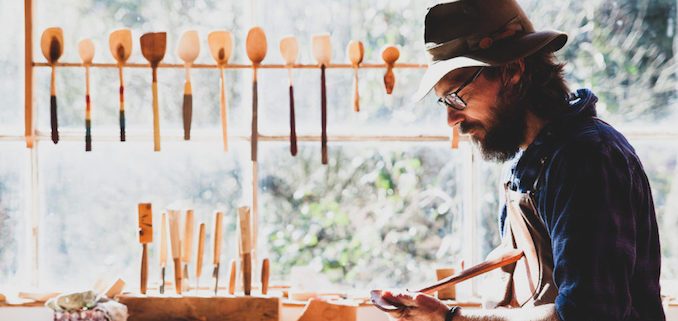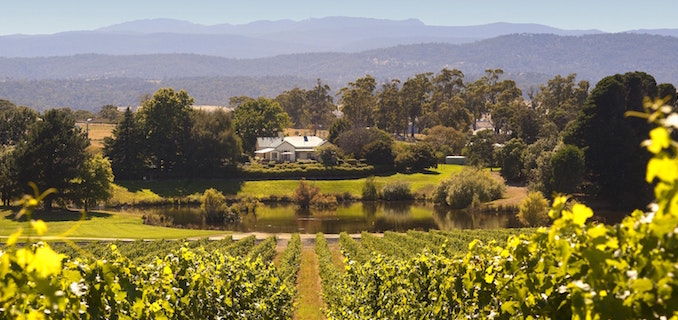
As of November 6, New South Wales residents can once again enjoy the wines, foods, arts, and crafts of Tasmania. Travel editor Winsor Dobbin has some suggestions.
From cool-climate wines to rustic cellar doors and fine dining overlooking vineyards, Tasmania’s wine tourism is a major drawcard for visitors. But there is much more to the Apple Isle than gourmet offerings, with two arts and crafts festivals scheduled for early December.
While Tasmania still represents less than one percent of the total Australian wine grape production, it produces 10% of the premium wine segment. Right now, Tasmania has over 160 individual licensed wine producers throughout the state, with around 2,000 hectares of vineyards.
Over the past five years, vineyard plantings in Tasmania have grown by more than 25%. With several different regions, ranging from the north-west to the Huon Valley in the deep south, Tasmania is producing an ever-increasing range of styles – and a constantly evolving choice of tasting options. Cellars door sales are arguably more important in Tasmania than any other region of Australia because over half the producers are tiny operations.
Their market is locals to whom they either sell direct, or at country shows and local produce markets. One of the fast-emerging regions for quality is the East Coast. Boomer Creek and Overtime are among the newest cellar doors on a strip that includes big names like Devil’s Corner, Spring Vale, Gala Estate, Craigie Knowe, Freycinet Vineyard, Apsley Gorge and Milton.
Meg’s Kitchen at Spring Vale, Milton and Devil’s Corner all have on-site restaurants.
The East Coast vineyards can be visited at the same time as Freycinet National Park, known for its granite peaks and spectacular beaches. Wineglass Bay has been named as one of the most beautiful beaches in the world.
In Bicheno, The Farm Shed, aka the East Coast Wine Centre always has several local wines available for tasting, or by the glass, and sells over 50 wines from more than 20 regional producers, large and small.
The star cellar door in the north of the state is Josef Chromy Wines, at Relbia, just down the road from Launceston Airport. The brainchild of one of the pioneers of the Tasmanian wine industry; this complex is a delight on every level. With vineyard views, lovely lakeside gardens and gazebos in which to relax, you will probably want to stick around.
Visitors can book a Go Behind the Label winery tour, tasting and lunch, the best regional tasting experience, or just settle for a lazy lunch in the relaxed surrounds.
Chromy is open seven days a week 10am-5pm and until last year was the venue for the Effervesence sparkling wine festival. Chief winemaker Jeremy Dineen, who has been on hand since day one, produces a wide range of sparkling and table wines. The menu specialises in Tasmanian produce (think starters like pinot-poached beetroots with Tongola goat cheese, or Tasmanian wallaby tartare, and mains like 20-hour cooked Scottsdale pork shoulder), perhaps with an older vintage of Zdar reserve chardonnay.
Lovers of sparkling wines should head to one of Australia’s finest sparkling producers Jansz Wine Room and Interpretive Centre at Pipers River, the northern best large cellar door. Share a cheese platter and compare some older vintages with current releases. Open daily.
Clover Hill is another star sparkling producer, while Velo Wines, just outside of Launceston, is home to Timbre Kitchen, which has built a reputation as one of Tasmania’s best small eateries.
The newest cellar door, offering gourmet plates, is Stoney Rise on the west bank of the Tamar River.
Star southern Tasmanian cellar door Frogmore Creek is perfect for spending a leisurely hour or two with glass in hand. Just down the road from Hobart Airport at Cambridge, it is home to an architect-designed complex with lovely views of the Coal River Valley, an extensive tasting room and a high-end restaurant that is open daily.
French-born winemaker Alain Rousseau is pushing the boundaries with newer varieties to the state like gamay and dornfelder, even some cabernet franc and petit verdot. From the menu maybe try Pipe Clay Lagoon oysters served with lemon and red wine mignonette, or local dry-cured salmon gravalax with chilli jam, yuzu gel, marbled kombu, sesame toasted nori and furikaki dust.
Frogmore Creek also has another restaurant, the Lounge, at Macq 01 hotel on the Hobart waterfront.
Home Hill in the deep south of the Huon Valley has an excellent restaurant, informed tastings, great views and a regular program of events. The Estate and Kelly’s Reserve pinot noirs are among Australia’s best.
Even further south is tiny Elsewhere, a fine small cellar, overlooking the Huon River at Glazier’s Bay outside Cygnet. Think bucolic countryside and a delightful small garden and tasting facility.
In the centre of Hobart, Glaetzer-Dixon Family Wines offers an urban cellar door tasting experience and the chance to peek inside a working winery, while Moorilla has a remarkable setting in the MONA complex.
In the Coal River Valley, Pooley Wines and Puddleduck both offer fun experiences for visitors, while Stefano Lubiana at Granton in the Derwent Valley produces stellar chardonnays and pinot noirs in a Tuscan setting.
Home Hill is among the venues for one of two arts and crafts fairs on the same week in December: from December 4-6.
Artists and Makers of the Huon – Art and Wine Trail sees local artisans join forces with two local wineries to welcome visitors to the Huon Valley, south of Hobart. This offers a rare opportunity to visit some of the secret studios hidden away in the valley and visit the artists in their creative environments.
Each of the participating businesses has implemented a Covid-19 safety plan.
Participating wineries are Kate Hill Wines and Home Hill Winery, along with several local artists. In Hobart, the designed:made – makers market will take place inHobart’s historic Town Hall and will feature some of Tasmania’s best emerging and established designers.
This design market is rapidly gaining a reputation as one of Tasmania’s best market-style events for high quality craft and design. Organised by designed:made inc. the design market includes a wide range of work including furniture, jewellery, ceramics, glass, textiles, prints and more, with nearly 40 designers and makers present. The stall holders are selected to ensure a mix of both established and emerging designers and makers, so there is always new and interesting work on display.
“This makers market showcases what talent Tasmania has to offer with high quality designed objects made in a host of different mediums. The event brings together a unique range of product which often is hard to access, and meeting the maker directly, definitely adds to the experience,” said Linda Fredheim, one of the event organisers.
“2020 has been a difficult year for many of Tasmania’s designers and makers. With galleries and markets closed, and general widespread uncertainty, artists and designers have struggled financially and creatively. Everyone has had to adapt. Lots of our designers took the opportunity to completely rethink their practice and used the time to develop new processes and perfect new techniques.”
See www.facebook.com/pages/category/Artist/Tasmanian-Artists-and-Makers-of-the-Huon-791028121265796/
www.designedmade.com.au/dm-makers-market-2020

